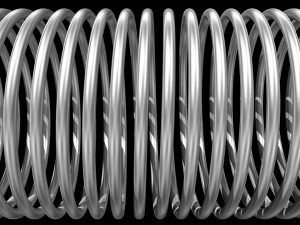
A spring is an essential hardware component used in a wide range of commercial and noncommercial applications. By definition, a spring is an elastic object that’s designed to store energy. When force, such as weight, is exerted upon a spring, the spring stretches while retaining the force’s energy. At the same, it a force in the opposite direction. But while all springs are designed to store energy, not all types of springs feature the same design.
Coiled Spring
Originating in the 1400s when they were first used in door locks, coiled is the most common type of spring. Also known as a helical spring, a coiled spring (depicted in the adjacent image) consists of a single piece of coiled metal. Like with other springs, it’s designed to store energy. The application of force causes a coiled spring to experience torsion in which it compresses while storing energy.
Machining Spring
While not as common as coiled springs, machining springs are often preferred for applications in which a specific amount of compression or torsion is required. They are called “machining springs” because they are manufacturing used a machine such as a lathe or milling machine. As a result, they can be designed to produce a specific amount of force or torsion. Coiled springs, on the other hand, are less precise regarding their force or torsion, which can hinder their performance and utility in certain applications.
Flat Spring
Most people associate with the word “spring” with tall and vertical coiled springs. Some springs, however, are flat rather than tall and vertical. Flat springs, for example, are manufactured from flat stock metal. With their flat design, flat springs are able to produce greater force relative to their height. The downside to flat springs is that they have shorter deflections.
Serpentine Spring
Serpentine springs have a unique design in which the metal wire zig-zags laterally. You’ll often find them used in furniture. Mattresses, for instance, often use serpentine springs. Also known as no-sag springs, serpentine springs prevent furniture, including mattresses, from sagging. Since they zig-zag laterally, they don’t succumb to the same stress-related deformation as traditional springs.
Garter Spring
Finally, a garter spring is a type of spring consisting of a single piece of circular-shaped coiled metal. When compressed, it’s designed to produce outward radial force. Garter springs are manufactured using a similar method as coiled springs. The only difference is that the ends of a garter spring are joined together, whereas the ends of a coiled spring are left open.
No tags for this post.